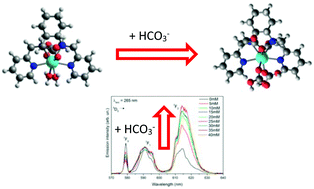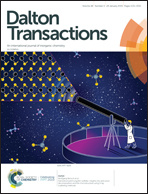Eu(iii) and Tb(iii) complexes of 6-fold coordinating ligands showing high affinity for the hydrogen carbonate ion: a spectroscopic and thermodynamic study†
Abstract
In the present contribution, four classes of Ln(III) complexes (Ln = Eu and Tb) have been synthesized and characterized in aqueous solution. They differ by charge, Ln(bpcd)+ [bpcd2− = N,N′-bis(2-pyridylmethyl)-trans-1,2-diaminocyclohexane N,N′-diacetate] and Ln(bQcd)+ (bQcd2− = N,N′-bis(2-quinolinmethyl)-trans-1,2-diaminocyclohexane N,N′-diacetate) being positively charged and Ln(PyC3A) (PyC3A3− = N-picolyl-N,N′,N′-trans-l,2-cyclohexylenediaminetriacetate) and Ln(QC3A) (QC3A3− = N-quinolyl-N,N′,N′-trans-l,2-cyclohexylenediaminetriacetate) being neutral. Combined DFT, spectrophotometric and potentiometric studies reveal the presence, under physiological conditions (pH 7.4), of a couple of equally and highly stable isomers differing by the stereochemistry of the ligands (trans-N,N and trans-O,O for bpcd2− and bQcd2−; trans-O,O and trans-N,O for PyC3A3− and QC3A3−). Their high log β values (9.97 < log β < 15.68), the presence of an efficient antenna effect and the strong increase of the Ln(III) luminescence intensity as a function of the hydrogen carbonate concentration in physiological solution, render these complexes as very promising optical probes for a selective detection of HCO3−in cellulo or in extracellular fluid. This particularly applies to the cationic Eu(bpcd)+, Tb(bpcd)+ and Eu(bQcd)+ complexes, which are capable of guesting up to two hydrogen carbonate anions in the inner coordination sphere of the metal ion, so that they show an unprecedented affinity towards HCO3− (log K for the formation of the adduct in the 4.6–5.9 range).



 Please wait while we load your content...
Please wait while we load your content...